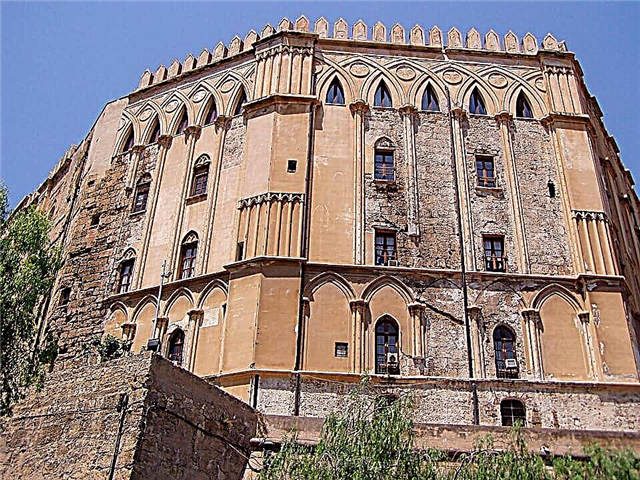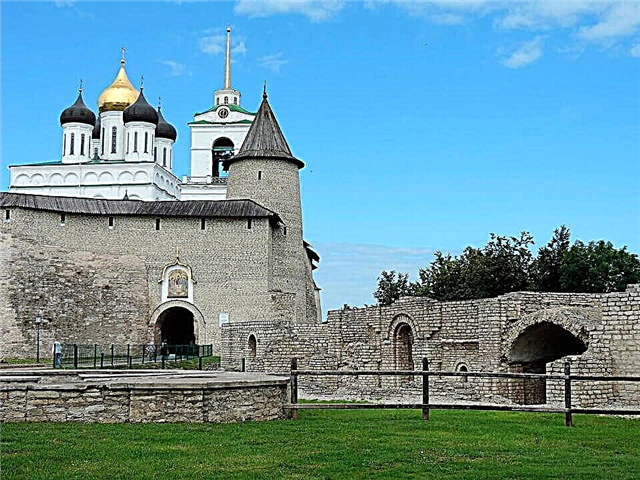The author of the novel "War and Peace" was born in the Tula province, spent his youth in Kazan, in his youth he served in the Caucasus and took part in the defense of Sevastopol. Lev Nikolaevich began his career as a writer in St. Petersburg. After retiring from military service, he lived in Moscow, traveled abroad and spent many years at home. The life of a great writer is a real journey!
Museum-estate "Yasnaya Polyana"

House of L. Tolstoy in the estate "Yasnaya Polyana"
Tolstoy's life began on the estate of his parents. Leva was born into a wealthy noble family. At first everything went well, but at 2 years old the boy lost his mother, and at 9 years old - his father. The future writer was left an orphan, and he was raised by his aunt Alexandra Osten-Saken.
Lev Nikolaevich lived in Yasnaya Polyana for over 50 years. Impressions of the beautiful nature and way of life in the village are reflected in Tolstoy's stories and novels.

Volkonsky's house in the Yasnaya Polyana estate
Nowadays, the estate, 14 km south-west of Tula, is a real tourist Mecca of Russia. Travelers from different parts of our country and from abroad come to visit the memorial house-museum of Tolstoy, look at the manor buildings, walk along the birch alley, the English park near the ponds and bow to the grave of the writer.
House on Plyushchikha in Moscow
In 1837, after the death of the writer's father, Alexandra Osten-Sacken's aunt took her older children to Moscow - to the house on Plyushchikha. Younger children, including Lyova, came here for the summer, and in the winter they went back to Yasnaya Polyana. Despite the loss of their parents, the family's life was carefree and happy. You can read about this in the first two books of Tolstoy "Childhood" and "Adolescence".

House at the address: Moscow, st. Plyushchikha, 11A, where L. Tolstoy lived
Lev Nikolayevich remembered the lessons of his first teacher, who replaced his mother, and was grateful to her for that. In his mature years, having moved to Yasnaya Polyana, Tolstoy opened his first school, and in a neighboring village, a second.
Now in the house of Lieutenant Colonel Shcherbachev on the street. Tolstoy, there is a branch of the State Traffic Inspectorate. Although the house is recognized as a cultural heritage site, its facades have been completely redesigned. The one-story building does not in any way resemble a mansion from the middle of the 18th century.
Museum in Kazan

House of the Yushkovs at the address: Kazan, st. Yapeeva, 15
When Alexandra Osten-Saken died, the Tolstoy family moved under the care of aunt Pelageya Ilyinichna Yushkova. IN Kazan Leo Tolstoy began a new life.
In 1844, the young man entered a higher educational institution - the Imperial Kazan University, but the students were a burden for him. Young Tolstoy considered university professors to be insufficiently competent, and exams as an empty formality. Lev Nikolayevich did not begin to receive an academic degree. In the spring of 1847 he left his studies and went to Yasnaya Polyana.
Today in the two-story house of the Gortalovs on the street. Yapeeva, 15, there is a museum of the writer. In its halls you can get acquainted with the Kazan period of Tolstoy's life and the history of the city in the middle of the 19th century.
The estate of A. D. Neguneva - E. A. Ivanova - P. Ivanov

House of Leo Tolstoy in Moscow on the street. Sivtsev Vrazhek, 34
In December 1850, the young Tolstoy rented a room in a mansion in the center of Moscow. Here he got the idea to write "The History of Yesterday". Lev Nikolayevich actively worked, was engaged in self-education - he studied languages, read a lot and developed a literary style. Tolstoy wrote "A Story from a Gypsy Life", but this work was rejected by the author and did not reach the readers.
One-storey stone house on the street. Sivtsev Vrazhek, 34, was built in the 1830s. The mansion was rebuilt several times, but, despite all the innovations, it managed to preserve the charm of the 19th century. The blackboard on the facade reminds that a great writer lived in the house.
Church of the Nativity of the Virgin on Seny in the Moscow Kremlin
Article: Church of the Nativity of the Virgin on the Seny of the Moscow Kremlin

View of the dome of the Church of the Nativity of the Virgin on Seny
In 1862, 34-year-old Tolstoy fell in love with a young girl, 18-year-old Sophia Bers. They decided to get married. The wedding took place in the Church of the Nativity of the Virgin - one of the most ancient monuments of the Moscow Kremlin. The church was built at the end of the XIV century by the order of the widow of Dmitry Donskoy - Princess Evdokia. Its architecture combines the traditions of the Vladimir-Suzdal and early Moscow schools.
The marriage between the young writer and the daughter of the court physician of Emperor Alexander II gave birth to the most significant work written by Tolstoy. The writer worked on "War and Peace" for 7 years. The great novel was expected to be a universal success. It has been translated into many languages and has captured the attention of the reading public for a long time. The Tolstoys' marriage lasted 48 years. Lev Nikolaevich and Sofya Andreevna gave birth to 13 children - 9 sons and 4 daughters.
Museum-estate in Nikolskoye-Vyazemsky

House Museum in Nikolskoye-Vyazemsky
In 1860, Tolstoy's elder brother died, and Lev Nikolaevich got another estate in the Tula province. It belonged to paternal relatives and was built in the second half of the 18th century. Tolstoy visited Nikolskoye-Vyazemskoye many times. In this estate, he began to write "War and Peace", composed the story "Cossacks" and several stories. In addition to literature, Tolstoy raised sheep, cows and was engaged in beekeeping.
Since 1999, the museum in Nikolskoye-Vyazemsky has been owned by Yasnaya Polyana. The exhibits collected here acquaint with the history of the Tolstoy family, and in the park you can see the spreading “Andrey Bolkonsky's oak”.
Station-Museum "Kozlova Zaseka"

Museum and station complex "Kozlova Zaseka"
The old railway station near Yasnaya Polyana became famous for the fact that famous guests of the writer came here. The artists I. Repin and I. Shishkin, the prose writer V. G. Korolenko and the author of books on religious and philosophical themes F. Strakhov visited the Kozlova Zaseka.
The half-station was opened in the 1860s. In 1902, a luggage compartment, a wide wooden platform, a railway house and a cellar appeared on it. The half-station turned into a station and became a remarkable place for fans of Tolstoy.
The writer used the station for the last time in mid-August 1910, when he was leaving for his eldest daughter Tatyana's estate. In 1918 the station was renamed Yasnaya Polyana, and in 2001 its historical name was returned. There is an exhibition in the building that tells about the role of the railway in Tolstoy's life.
Literary and Ethnographic Museum in the village of Starogladovskaya

View of the building of the Literary and Ethnographic Museum in the village of Starogladovskaya
The ancient settlement on the territory of the Chechen Republic is associated with the beginning of the writer's literary biography. Lev Nikolaevich lived in Starogladovskaya in 1851-1853 and wrote the story "Childhood". Unfortunately, the memorial house has not survived. The exhibits are housed in the school, which was erected in 1913 and named after Tolstoy.
This museum contains materials about the writer's participation in the Caucasian War and the last work of Tolstoy about the Caucasus - the story "Hadji Murad". In addition to literary relics, in the halls you can see an ethnographic corner dedicated to the life of the Cossacks and highlanders in the middle of the 19th century.
Tolstoy Center on Pyatnitskaya in Moscow

View of the Tolstoy Center from Pyatnitskaya Street
In 1857-1858, Tolstoy left military service and rented a stone house in Moscow. Here the young writer wrote the story "The Cossacks", the stories "The Lost" and "Three Deaths". M. Saltykov-Shchedrin, B. Chicherin and the Aksakov brothers came to visit Lev Nikolaevich in Zamoskvorechye. In addition, at this time Lev Nikolaevich became close to the Russian writers A. Fet and A. Ostrovsky.
In an old mansion of the late 18th century at 12 Pyatnitskaya, exhibitions, concerts and meetings with writers are held. The Moscow Museum is famous for interesting excursions, theatrical performances and interactive activities for children.
Museum-estate in Khamovniki

View of the museum-estate in Khamovniki from the park of the estate
In 1882, Tolstoy acquired an old Moscow estate in the city center. Here the writer and his family lived in the cold season, and in the summer they left for the family estate in the Tula province. Chapters of the novel "Resurrection" and three stories were written in Khamovniki.
Building on st. Leo Tolstoy, 21, is very fond of admirers of Lev Nikolaevich's work. In the halls on two floors, living rooms have been recreated and more than 6,000 items that belonged to the writer's family are kept.
State Museum of the Writer in Moscow

View of the Leo Tolstoy State Museum from Prechistenka Street
After the death of Lev Nikolaevich, in 1911 the first literary museum of Tolstoy appeared in the city. It was created thanks to the efforts of Bryusov, Bakhrushin, Bunin, Veresaev, Repin, Gorky, Stanislavsky, Pasternak, Nemirovich-Danchenko, Yablochkina, wife, children and friends of Lev Nikolaevich.
A beautiful mansion stands on the street. Prechistenka, 11/8. The building with a portico and columns was erected in 1817 in the best traditions of the Moscow Empire style. The spacious rooms display old and modern editions of Tolstoy's works, manuscripts and paintings.
Cultural center in Zheleznovodsk

L. Tolstoy Cultural Center in Zheleznovodsk
A small house for postal stagecoaches is an architectural monument of the 19th century. In addition to Tolstoy, the Ossetian poet and Russian artist N. Yaroshenko, the Ossetian poet KL Khetagurov, the Caucasus explorer A.V.
In 1981, the one-story house was taken under state protection as a valuable architectural monument. Inside there is an exhibition “Travel to the Land of Love and Inspiration”, which tells about the writer's stay in the Caucasus.
Memorial Museum "Astapovo"

General view of the memorial museum complex "Astapovo"
In early November 1910, a very elderly Tolstoy found himself in the house of the head of the Astapovo station. The writer was seriously ill, and on November 10, his heart stopped beating.
Until the end of the 1930s, the memorial station was carefully preserved by local residents, and in 1946 Astapovo became a museum. Nowadays, the museum complex includes the station itself and the houses located nearby. All buildings look like they were at the beginning of the last century.
Railway station "Shchekino"

View of the railway station "Shchekino"
There is a railway station 8 km from Yasnaya Polyana, which keeps the memory of Lev Nikolaevich's last journey. In 1910, Tolstoy quarreled with his wife, took a train, left for Astapovo and died.
Now "Shchekino" is not a functioning station, but a memorial dedicated to the writer. The building has a stylized ticket office and a waiting room for passengers. An old carriage stands on the rails. A monument to Tolstoy can be seen in front of the station, and there are changing exhibitions in the building.
Burial place in Yasnaya Polyana

View of the grave of L. Tolstoy in Yasnaya Polyana
On November 9, 1910, the body of the deceased Lev Nikolaevich Tolstoy was transported in a coffin without a cross to Yasnaya Polyana. They carried him to the grave in their arms. The writer was buried in the forest, where he wanted to find his last peace. The burial took place without flowers, church singing, incense and solemn speeches.
The grave looks very modest. There is no cross on it. By the will of Lev Nikolaevich, no flowers are brought here and no wreaths are laid. However, despite this, a low mound with fresh grass is one of the most sacred burials of our time.











